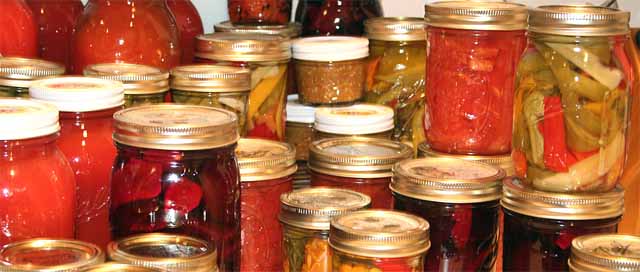12 Lifesaving Canning Rules

Know your canning rules. But don’t worry, this is not hard. It’s really quite easy to do safe canning.
When it’s that time of year for canning your garden bounty, or when canning any time of the year, before you dust off your canner and heat the stove, first refresh your memory with these 12 lifesaving canning rules.
Having just canned 18 pints of beans myself, time for a refresher:
Canning is entirely safe when done properly. However certain precautions should be observed.
Generally, I will say that the most important thing to remember (especially for newbies) is to follow the instructions of a modern canning recipe. From a trusted source.
Choose a reliable source for home canning recipes. Why? Because they are tested, proven, and designed to provide a wide margin of safety. I use the following two canning books:
Ball Complete Book of Home Preserving
(view on amzn)
USDA Complete Guide to Home Canning
Canning Rules For Safety
Canning Jar Size
Most people use pint size or quart size canning jars. But don’t use jars larger than a quart. Home canning technology cannot guarantee that larger quantities will be sufficiently heated through for enough time. Rather, the food on the outside will overcook, while that on the inside won’t get hot enough for food safety.
Water Bath Canner
A water-bath canner may only be used for high acid foods such as tomatoes, fruits, rhubarb, sauerkraut, pickles, and jams/jellies. However a pressure canner MUST be used for low acid foods including vegetables, meats, and stews.
Most popular Pressure Canner: Presto (view on amzn)
Modern Canning Recipes
Use only modern canning recipes from reliable sources (especially when first learning canning as a beginner). I’ve linked the two recommended books above.
Jar Lids
Never reuse jar lids. Used lids aren’t reliable for sealing correctly. If a screw-on band is rusty or bent, it won’t work right and should be discarded and replaced.
Jar Type
Don’t use antique or ‘French’ -type canning jars. They aren’t as safe as the modern, regular ‘Ball, Kerr’ type.
Jar Rims
Check the jar rims carefully every year by running your finger over the top of the rim and checking for nicks. Even the tiniest nick makes the jar unusable for canning. A nicked jar rim won’t seal reliably.
Raw Pack
Raw pack is not safe for certain foods: beets, all kinds of greens (spinach, etc.), white potatoes, squash, okra, a tomato/okra combination, and stewed tomatoes. Refer to the recipes.
Head Space
You must allow the correct amount of space (head-space) between your food, together with the liquid that covers it, and the jar lid (follow the recipe instructions). Until you get used to the head space dimensions, you might use the following tool:
When To Start Counting – Water Bath Method
Water Bath Method: Do not begin counting the processing time until after the water in the canner comes to a rolling boil
When To Start Counting – Pressure Canner Method
Pressure Canner: Do not begin counting the processing time until after steam has vented for 10 minutes AND until after the pressure gauge has risen to the recommended pressure (after placing the weight on the vent pipe after the venting time).
Time & Pressure
Process the full recommended time (and at the recommended pressure if using pressure canner).
Jars That Don’t Seal
If a jar did not seal, discard the lid, check to see if the jar rim is chipped (discard jar), check for food residue on the rim (clean), put on a new lid, and reprocess. Or consume the food and/or put in the refrigerator as you would any other leftover food for later consumption.
Some recommendations gathered from The Encyclopedia of Country Living
Top-of-the-line “All American Pressure Canner”
All American Pressure Cooker Canner
(view on amzn)
Add your own recommendations below:
